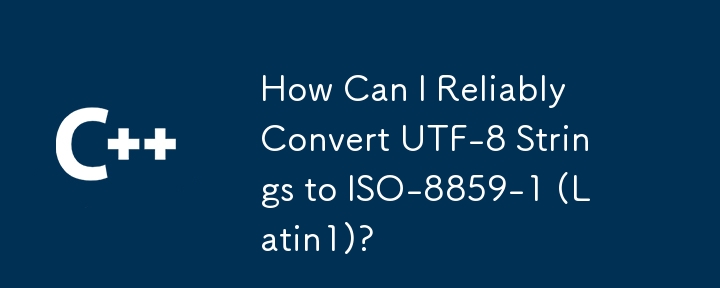How Can I Reliably Convert UTF-8 Strings to ISO-8859-1 (Latin1)?
Jan 08, 2025 pm 02:16 PM
Reliable UTF-8 to ISO-8859-1 (Latin-1) String Conversion
Converting text from UTF-8 to ISO-8859-1 (Latin-1) can be tricky. While seemingly simple, many developers encounter problems. The common mistake is using Encoding.GetString() directly after the conversion attempt. Here's a robust solution:
This approach avoids the pitfalls of directly using Encoding.GetString() after a simple byte array conversion. Instead, it ensures proper handling of encoding differences.
-
Get UTF-8 Bytes: Use
utf8.GetBytes(Message)to obtain the UTF-8 byte representation of your input string (Message). -
Convert to ISO-8859-1 Bytes: Employ
Encoding.Convert(utf8, iso, utfBytes)to convert the UTF-8 bytes to ISO-8859-1 bytes. This step is crucial for handling potential character mapping issues. -
Decode ISO-8859-1 Bytes: Finally, use
iso.GetString(isoBytes)to decode the resulting ISO-8859-1 bytes into a string (msg). This ensures that the final string is correctly interpreted using the target encoding.
Following these three steps provides a reliable method for converting UTF-8 strings to ISO-8859-1, preventing the common errors associated with direct string decoding.
The above is the detailed content of How Can I Reliably Convert UTF-8 Strings to ISO-8859-1 (Latin1)?. For more information, please follow other related articles on the PHP Chinese website!

Hot Article

Hot tools Tags

Hot Article

Hot Article Tags

Notepad++7.3.1
Easy-to-use and free code editor

SublimeText3 Chinese version
Chinese version, very easy to use

Zend Studio 13.0.1
Powerful PHP integrated development environment

Dreamweaver CS6
Visual web development tools

SublimeText3 Mac version
God-level code editing software (SublimeText3)

Hot Topics
 What are the types of values returned by c language functions? What determines the return value?
Mar 03, 2025 pm 05:52 PM
What are the types of values returned by c language functions? What determines the return value?
Mar 03, 2025 pm 05:52 PM
What are the types of values returned by c language functions? What determines the return value?
 What are the definitions and calling rules of c language functions and what are the
Mar 03, 2025 pm 05:53 PM
What are the definitions and calling rules of c language functions and what are the
Mar 03, 2025 pm 05:53 PM
What are the definitions and calling rules of c language functions and what are the
 C language function format letter case conversion steps
Mar 03, 2025 pm 05:53 PM
C language function format letter case conversion steps
Mar 03, 2025 pm 05:53 PM
C language function format letter case conversion steps
 Where is the return value of the c language function stored in memory?
Mar 03, 2025 pm 05:51 PM
Where is the return value of the c language function stored in memory?
Mar 03, 2025 pm 05:51 PM
Where is the return value of the c language function stored in memory?
 How do I use algorithms from the STL (sort, find, transform, etc.) efficiently?
Mar 12, 2025 pm 04:52 PM
How do I use algorithms from the STL (sort, find, transform, etc.) efficiently?
Mar 12, 2025 pm 04:52 PM
How do I use algorithms from the STL (sort, find, transform, etc.) efficiently?
 How does the C Standard Template Library (STL) work?
Mar 12, 2025 pm 04:50 PM
How does the C Standard Template Library (STL) work?
Mar 12, 2025 pm 04:50 PM
How does the C Standard Template Library (STL) work?









